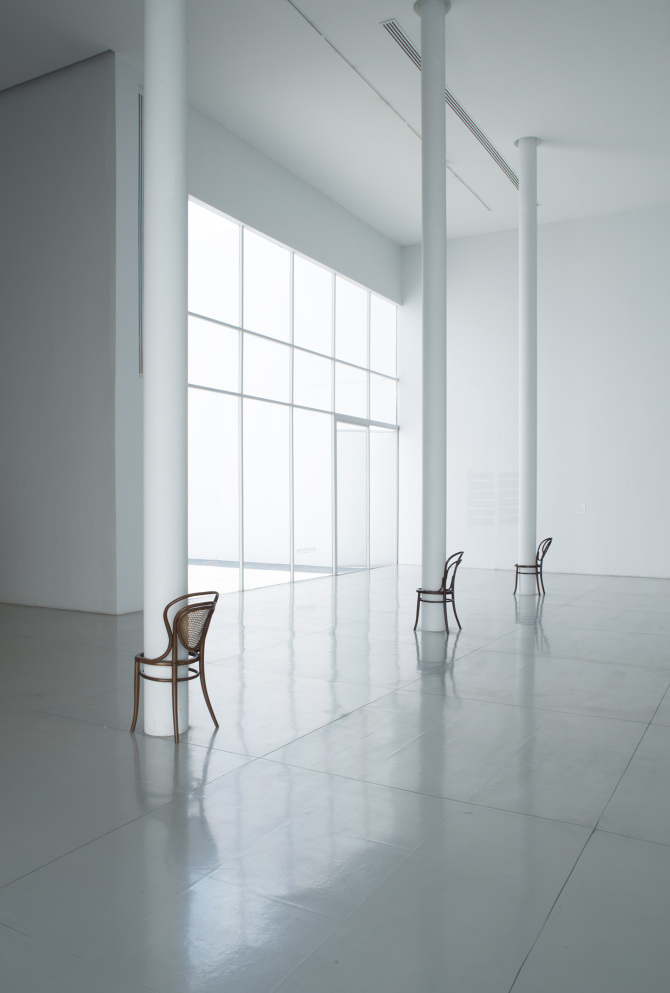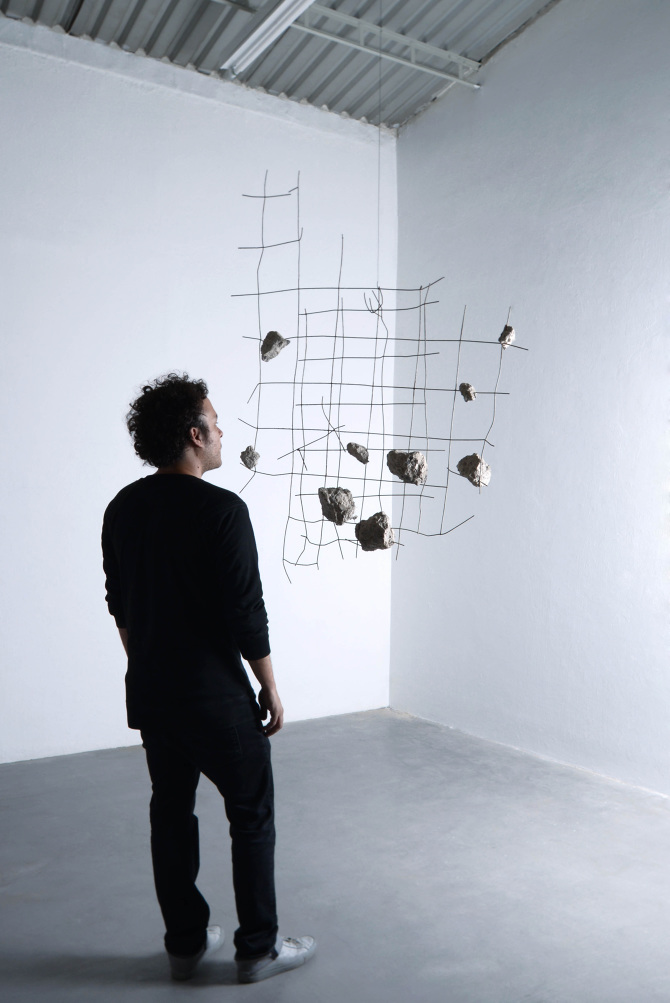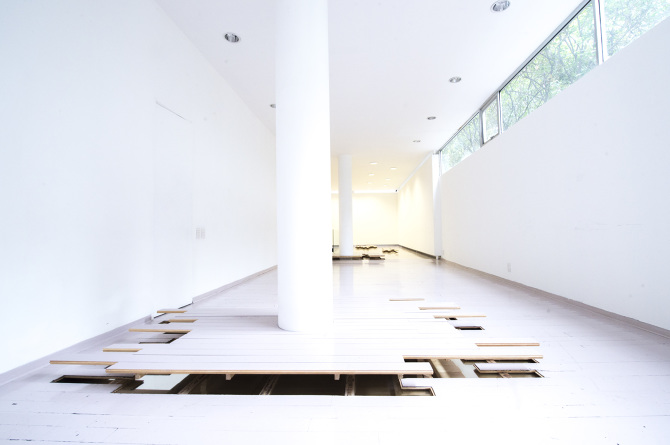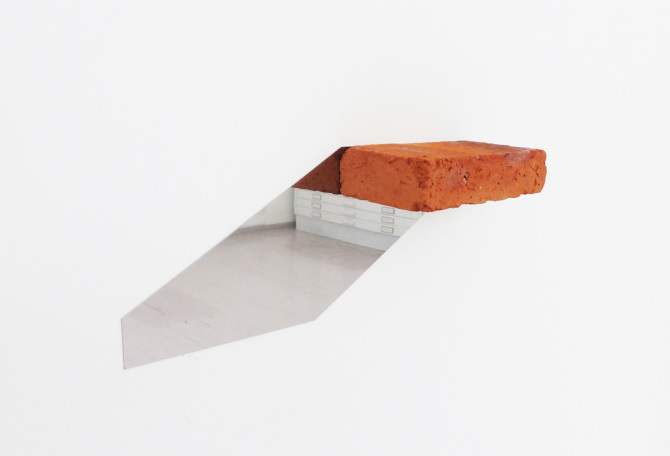Interview with Mario Navarro
Mario Navarro is a Mexican artist who uses the exhibition space as part of his practice. He was just part of the exhibition at Baxter Street at the Camera Club of New York, Polaris, curated by Joey Lico. Martha sat with him in his impeccable studio in Bushwick to have a conversation about space and art-making.
Martha Naranjo Sandoval
I want to start by talking about Aestetical Irregularities and its different iterations.
Mario Navarro
I think of Aesthetical Irregularities as an ongoing project focused on my interests around architecture and space and on how to use the space where you are showing the work. I like to take advantage of the exhibition space to generate site-specific architectural interventions. The first time I executed this idea was in Mexico City, where I cut out the hardwood floor from the gallery. Then I lifted up those pieces and covered the holes below it with mirrors to generate a void, a kind of emptiness below the elevated floor. But I think about this void, not as a lack of something ,but more as a new space that’s generated by taking away the original elements of the space.
I will create another iteration soon in Tokyo at Komagome Soko, a project space that that is run by the gallery SCAI, The Bathhouse. Right now I’m in the planning stage, but in the end, it’s going to be a site-specific installation using the expository space to generate this intervention. The idea is also to expand the space, to create new forms, new ideas, and new perceptions of the space itself.
Martha
It seems that the gallery itself is your material.
Mario
It’s probably the main material. It’s the same that is complemented by other materials but the idea is to mainly use the gallery’s basic elements.
Martha
The space itself.
Mario
Yes, the space itself to generate a new way of reading that specific architectural site.
Martha
It’s interesting how you perceive the empty spaces. I feel it’s like silence in music. It’s not nothing, it’s part of the composition. That gets lost when the space is not as important in the work. When a space is just a place to hang work. But in your work, the space is the work.
Mario
I like the way you compare it to music. That’s very accurate. I think an empty gallery has a lot of potential to create work without bringing anything from the outside. That’s the irregularity that I’m talking about. How to make it irregular aesthetically by using the floor, the walls, the structures, whatever you can find to transform any given space.
Martha
It’s also interesting how you think about mirrors as creating empty spaces. I think that it prolongs the space more than emptying it.
Mario
Well, as in the case of the Mexico City show Aesthetical Irregularities, I see mirrors as an emptiness because in the end, they reflected the white walls of the space and they read as holes. But I use mirrors often, and mirrors don’t work the same every time. In the piece The Original Accident, which consists of vertical and horizontal two-way mirrors, the space gets unfolded. Also, the material properties play with space as the light refracts into the mirror. Then you have the reflection of the other reflections and a shadow. Because in the end, it’s an object that’s occupying a space. I like the idea that one single material can have more than one reaction to an external factor. And then there is how I used them for Isodomun. I think that it unfolds some parts of the work, but then these cut the work into different sections. I see it as a new body, as a new element. Mirrors have all those possibilities.
Martha
Another thing that happens with how you use the space, intervening with it, is that it can’t quite return the same state. In a way, you scar the space.
Mario
It’s something that happens but I haven’t really explored. If you go to the gallery in Mexico City right now, you can see all the marks of my piece on the floor. The gallery owner loves it, but it is funny how even when you go to see another show you can see the traces of mine. Some other artist told me they don’t like to show on top of my traces.
Martha
It is as if wherever you present will always remember that you presented there.
Mario
Actually, I’m in the planning stages of a photography project. I want to go to different sites and make cut-outs on the floor, lift the pieces, and photograph them. Then I’d put them back and photograph it again. Making a comparison between how the space was originally, then when the floor was cut, and then after. I’m still working on it, but I enjoy the notion of how a work leaves a trace. It’s going to be there for as long as that floor remains the same.
Martha
Yeah, it’s reminiscent of Gordon Matta-Clark.
Mario
Yes, but I think that Matta-Clark was very incisive. He cut places and he wanted to show what was underneath. I think what I do is more like reorganizing. I want to make the space different by just changing a small thing and then putting it back in as it was. But of course, he is a big influence in my work.
Martha
Your work is obviously very tied to architecture, but how did you make the leap from architecture to art?
Mario
The process was very organic. When I was studying architecture I was interested in contemporary art, especially in sculpture and installation. I also had a teacher who is a great artist. I was very interested in ephemeral architecture but my school was very traditional. I wanted to explore ways of transforming architecture, not just in building a house or a conventional space. I always had the feeling that I needed to do something different. I began working with a curator and then with an artist. This helped me understand many aspects of contemporary art. I realized that I could develop my own ideas through architecture and make something that would not necessarily be seen as architecture.
It all started because of a friend, who is a curator, that invited me to create work for a show he was organizing. Then someone invited me to participate in another show, and so on.
It was all very natural. That is also how my process is. When I am working on developing a new idea, if I get stuck, I leave it to rest and come back to it after, but that could be in a year. I don’t like to force things. So that’s how the transition happened. But in the end, everything I do is seen through architecture in a way. I work a lot like an architect with models, plans, etc.
Martha
I think it’s interesting how you say that you see a lot of things through the lens of an architect. I’m originally a filmmaker and I feel that every time I create a piece, even if it’s a book, I think about how would I edit it as if it were a film. All of my work is measured through film language. Maybe because it was the first art that I really understood how to control. It makes sense to me that you make things in an architectural way.
Mario
I don’t work like an architecture studio necessarily, but I do process ideas like that. I love starting my ideas on paper. Then I make it precise with software, even though I like if the final result is not necessarily what I planned. I end up with a lot of diagrams for each work. Even if the end result is just a print, I sketch if “it should be hung like this, at this height…” I like how detail-oriented the architectural process is. I hate drawing floor plans, but for my works, it is the best way to plan them. I think that it gives me a lot of peace of mind because I know that for every piece there’s a history that backs it all up. All those plans, drawings, research, texts, etc; I think that is part of the work. You can see how it developed. hat includes models. If I am making a sculpture, I want to see the dimension of it. It’s very architectural.
Martha
It’s very interesting that there’s all of this work behind it, and yet it is so minimal.
Mario
Yes, that’s something that I like. You might see the work and think about its simplicity, but behind it is an idea that was developed step by step. I test a lot out before the final idea. And then it’s funny the original idea is always so different from the final piece I predicted.
But on the other hand, I’ve been making this work, the Stone Isodomums. I’m trying to lay off a bit of this carefully planned process. I go to this place where they sell masonry materials like marble, granite, and bricks and buy leftovers that I like. I take them to my studio and then begin working by arranging them and creating compositions. It’s freeing because you never know what you’re going to find. You never know what you’re going to use, how the compositions are going to end up. In the end, the result is a very architectural minimal work but nurtured by many different variables.
Martha
Now that you mention using this rearrangement of objects I want to talk about Future Islands. It’s interesting how you take away the chairness of a chair by taking away its ability to be sat on. But the chair remains as a thing, free of its use.
Mario
That’s a site-specific work that fits perfectly in Aesthetical Irregularities. The idea is to take away all the utilitarian values of the Thonet chair by imposing it on the space. It’s a domestic object that everyone uses, not to mention the historic values of its design. But how do you merge it with the space and remove all the utilitarian value of the object? And even when you merge them, the chairs are never touching the architecture or the columns, they’re just surrounding it. I like the idea of surrounding the architecture of the space.
I also have this version of the chair with a short concrete column. But that’s different and I like it for different reasons. It’s almost like a pallet made out of concrete. That was the first work that I made. I took one or two pallets and I made a mold out of the wood. Then I poured concrete in and let it dry. In the end, it’s the same object formally speaking, but out of a different material. I thought about it as a way of transforming an object with its own material.
Martha
Like an indexical relationship.
Mario
Exactly. You’re using the same object to transform it into itself. And by taking away its utilitarian value, the result can only be read as a sculptural object.

Mario Navarro, Future Islands, 2016. Insitu intervention: Columns, Thonet Era chairs. Variable dimensions.
Martha
I think this is good segway to talk about the piece that you showed at Baxter Street at the Camera Club of New York for the show Polaris.
Mario
For that show, I wanted to do something site-specific as well. I like that space a lot. It’s kind of a storefront and looks like a gallery. But then I began discovering the little hidden spaces and the space below. One of the things that caught my attention were the two cupboards, one above the entrance and another one above the window. It’s a very unusual thing but it’s another volume inside the showroom. It’s interesting because it’s not in use and in a way it’s taking space away from the gallery.
I wanted to make that space apparent by giving it value inside the gallery space. I took one of the holes and extruded it into a volume or body. I just wanted to unfold or to extend the size and shape of the hole into an architectural element. The structure came out of the cupboard and straight down to the floor. I chose to make it out of a mesh screen.
Martha
I think it’ very important that you chose to do it with the cupboard that is on top of the door and not the one on top of the window. It is the first thing you see when you enter the show, but you might not necessarily think it’s a piece in the exhibition because of how architectural it is. Maybe the materials give it away, but I kept wondering what a person that has never been to the space before thought about it.
Mario
It had to be the one by the entrance. The one by the window would be interesting but this way the piece is saying “Hey, I’m here.” It’s a new body in the entrance of the space, so you have to move around it. Its form comes directly from a shape in the building itself. It’s also imposing spatially but not visually since the mesh allows you to see through it. A lot of people didn’t notice the work and some bumped into it, even though it’s was a large scale piece.
Martha
It becomes important that a lot of people were bumping into it.
Mario
Yeah, it’s very fragile. During the opening, a lot of people were hitting it and its shape got twisted. I’m very detailed oriented. Things have to be perfect. For this one, even though I went into a lot of details, I liked that it was very fragile. When the show began, it was in the perfect position, at the right angle. When the opening ended it was twisted. A friend told me, “Hey, this doesn’t look good. You should make it straight,” and I said, “No, I know that people have been moving it, but I like it.” The same material allows it to bend.
Martha
It makes it into living piece because the context is changing it constantly.
Mario
That’s right, I like at the end, how the work was behaving and how people were behaving around it. For me, it was an experiment and an exercise to free the perfectionism in the fabrication of the piece.
Martha
How long have you been in New York?
Mario
I’ve been here two years. I moved because my partner was moving here to do her master’s degree at the Pratt Institute, so I decided to move as well.
Martha
How do you feel it’s different being an artist here and being an artist in Mexico?
Mario
In New York, there is a huge artist community. There’s this feeling that I like that everyone is an artist. Artists here are usually engaging with other artists through studio visits. I think that in Mexico it’s harder to achieve that sense of community.
Martha
One of the things that happened to me when I moved here is that I realized there are tools for very specific things, where in Mexico, we will use the same tool for more than one purpose. That allows you to be more creative and not be tied to a specific tool. You can…
Mario
You work it out, but that’s the context that we grew up in. We probably don’t even have all the resources but you learn to solve problems with what you have around you.
Martha
How do you think, if at all, that being Mexican and from Guadalajara, affects the way you look at art? You are from Guadalajara, right?
Mario
I’m from Tijuana. A lot of people think I’m from Guadalajara because I studied architecture there, and my career as an artist developed in Guadalajara.
Martha
I’m really sorry about that. So how do you think being from where you are from affects your work? If at all.
Mario
It’s complicated. I’m not a person that thinks as a Latin American artist you produce Latin American art. I wouldn’t say that my work it’s only influenced by Latin American culture. Sometimes It is even hard to pin-down a Mexican identity.

Mario Navarro, Yesterday, Today and Tomorrow, 2014. Found object in demolished house. 140 x 115 x 15 cm.
Martha
I know what you mean. I don’t subscribe either to the idea that there is a Latin American-ness.
Mario
Exactly.
Martha
And of course your work is somehow influenced from where you’re from, but in another way, it’s not because you’re a particular person. No one expects American art to be all the same, but somehow people expect Latin American art to be similar.
Mario
I think that’s true, I identify a lot with Brazilian artists. I think that my line of work is very similar and even though they’re Latin American, I don’t really think that has anything to do with the reasons why I identify with them. For me, it’s more a personal interest.
But I do sometimes stop myself to think, “How does growing up in Tijuana influence me?” And it’s an influence, of course. I always disliked the architecture there. It’s just a copy of Californian style architecture but Mexicanized. There is a baroque reinterpretation. As an architect, it all starts with the house I grew up in. My house was this kind of a Californian style house if you can even call it a style. Ornamentation with no reason. Also being in Guadalajara affected the influence of modernist architecture. Architects like Luis Barragán were important factors in my work. Everything influences you, and then you start to define yourself depending on where you are, who you meet, etc. And of course, I am Latin American artists.
Martha
Yeah, but before that you were just an artist.
Mario
Exactly. I’m not sure my work really defines that aspect. Most of the artists I follow are Latin Americans. I love being Latin American, I love being Mexican and I’m proud of my heritage.


